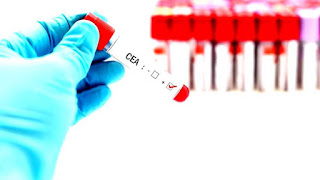
Carcinoembryonic antigen (CEA) describes a set of highly related glycoproteins involved in cell adhesion. CEA is normally produced in gastrointestinal tissue during fetal development, but the production stops before birth. Therefore, CEA is usually present only at very low levels in the blood of healthy adults. However, the serum levels are raised in some types of cancer, which means that it can be used as a tumor marker in clinical tests. Serum levels can also be elevated in heavy smokers.
CEA are glycosyl phosphatidyl inositol (GPI) cell-surface-anchored glycoproteins whose specialized sialofucosylated glycoforms serve as functional colon carcinoma L-selectin and E-selectin ligands, which may be critical to the metastatic dissemination of colon carcinoma cells. Immunologically they are characterized as members of the CD66 cluster of differentiation. The proteins include CD66a, CD66b, CD66c, CD66d, CD66e, CD66f.
Video Carcinoembryonic antigen
History
CEA was first identified in 1965 by Phil Gold and Samuel O. Freedman in human colon cancer tissue extracts.
Maps Carcinoembryonic antigen
Diagnostic significance
The CEA blood test is not reliable for diagnosing cancer or as a screening test for early detection of cancer. Most types of cancer do not result in a high CEA level.
Serum from individuals with colorectal carcinoma often has higher levels of CEA than healthy individuals (above approximately 2.5 µg/L). CEA measurement is mainly used as a tumor marker to monitor colorectal carcinoma treatment, to identify recurrences after surgical resection, for staging or to localize cancer spread through measurement of biological fluids. CEA levels may also be raised in gastric carcinoma, pancreatic carcinoma, lung carcinoma, breast carcinoma, and medullary thyroid carcinoma, as well as some non-neoplastic conditions like ulcerative colitis, pancreatitis, cirrhosis, COPD, Crohn's disease, hypothyroidism as well as in smokers. Elevated CEA levels should return to normal after successful surgical removal of the tumor. of what? for what?.
CEA elevation is known to be affected by multiple factors. It varies inversely with tumor grade; well-differentiated tumors secrete more CEA. CEA is elevated more in tumors with lymph node and distant metastasis than in organ-confined tumors and, thus, varies directly with tumor stage. Left-sided tumors generally tend to have higher CEA levels than right-sided tumors. Tumors causing bowel obstruction produce higher CEA levels. Aneuploid tumors produce more CEA than diploid tumors. Liver dysfunction increases CEA levels as the liver is the primary site of CEA metabolism.
Regions of high CEA levels in the body can be detected with the monoclonal antibody arcitumomab.
Antibodies to CEA are also commonly used in immunohistochemistry to identify cells expressing the glycoprotein in tissue samples. In adults, CEA is primarily expressed in cells of tumors (some malignant, some benign) but they are particularly associated with the adenocarcinomas, such as those arising in the colon, lung, breast, stomach, or pancreas. It can therefore be used to distinguish between these and other similar cancers. For example, it can help to distinguish between adenocarcinoma of the lung and mesothelioma, a different type of lung cancer which is not normally CEA positive. Because even monoclonal antibodies to CEA tend to have some degree of cross-reactivity, occasionally giving false positive results, it is commonly employed in combination with other immunohistochemistry tests, such as those for BerEp4, WT1, and calretinin.

Genetics
CEA and related genes make up the CEA family belonging to the immunoglobulin superfamily.
In humans, the carcinoembryonic antigen family consists of 29 genes, 18 of which are normally expressed. The following is a list of human genes which encode carcinoembryonic antigen-related cell adhesion proteins: CEACAM1, CEACAM3, CEACAM4, CEACAM5, CEACAM6, CEACAM7, CEACAM8, CEACAM16, CEACAM18, CEACAM19, CEACAM20, CEACAM21

See also
- List of histologic stains that aid in diagnosis of cutaneous conditions

References

External links
- Carcinoembryonic Antigen at the US National Library of Medicine Medical Subject Headings (MeSH)
- CEA at Lab Tests Online
- CEA: analyte monograph from The Association for Clinical Biochemistry and Laboratory Medicine
Source of the article : Wikipedia


